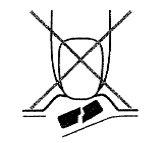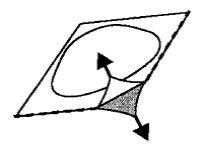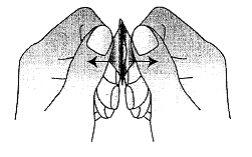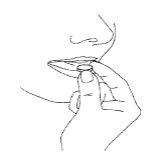
MIRTAZAPINE FLAS BLUEFISH 45 mg ORALLY DISINTEGRATING TABLETS
Ask a doctor about a prescription for MIRTAZAPINE FLAS BLUEFISH 45 mg ORALLY DISINTEGRATING TABLETS

How to use MIRTAZAPINE FLAS BLUEFISH 45 mg ORALLY DISINTEGRATING TABLETS
Introduction
Package Leaflet: Information for the User
Mirtazapine Flas Bluefish 45 mg Orodispersible Tablets EFG
mirtazapine
Read all of this leaflet carefully before you start taking this medicine because it contains important information for you.
- Keep this leaflet, you may need to read it again.
- If you have any further questions, ask your doctor, pharmacist, or nurse.
- This medicine has been prescribed for you only. Do not pass it on to others. It may harm them, even if their signs of illness are the same as yours.
- If you get any side effects, talk to your doctor, pharmacist, or nurse. This includes any possible side effects not listed in this leaflet. See section 4.
Contents of the pack and other information
- What Mirtazapine Flas Bluefish 45 mg Orodispersible Tablets are and what they are used for
- What you need to know before you take Mirtazapine Flas Bluefish 45 mg Orodispersible Tablets
- How to take Mirtazapine Flas Bluefish 45 mg Orodispersible Tablets
- Possible side effects
- Storage of Mirtazapine Flas Bluefish 45 mg Orodispersible Tablets
Contents of the pack and further information
1. What Mirtazapine Flas Bluefish 45 mg Orodispersible Tablets are and what they are used for
Mirtazapine Flas Bluefish belongs to a group of medicines called antidepressants. This medicine is used to treat depression in adults. It may take 1 to 2 weeks before mirtazapine starts to work. After 2 to 4 weeks, you may start to feel better. You should see your doctor if you do not feel better or if you feel worse after 2 to 4 weeks. For more information, see section 3 "When can you expect to feel better".
2. What you need to know before you take Mirtazapine Flas Bluefish 45 mg Orodispersible Tablets
Do not take Mirtazapine Flas Bluefish
- if you are allergic to mirtazapine or any of the other ingredients of this medicine (listed in section 6).
- if you are taking or have taken in the last two weeks medicines called monoamine oxidase inhibitors (MAOIs).
Warnings and precautions
Consult your doctor or pharmacist or nurse before starting to take Mirtazapine Flas Bluefish.
DO NOT TAKE OR CONSULT YOUR DOCTOR BEFORE STARTING TO TAKE mirtazapine:If you have ever had a severe skin rash or peeling of the skin, blisters, or sores in the mouth after taking mirtazapine or other medicines.
Children and adolescents
Mirtazapine Flas Bluefish should not normally be used in the treatment of children and adolescents under 18 years of age because it has not been shown to be effective. At the same time, you should know that in patients under 18 years of age, there is an increased risk of adverse effects such as suicidal attempts, suicidal thoughts, and hostility (mainly aggression, confrontational behavior, and irritation) when taking this class of medicines. Nevertheless, the doctor may prescribe Mirtazapine Flas Bluefish to patients under 18 years of age when he decides what is most convenient for the patient. If the doctor has prescribed Mirtazapine Flas Bluefish to a patient under 18 years of age and you want to discuss this decision, please go back to your doctor. You should inform your doctor if any of the symptoms mentioned above progress or if you experience complications when patients under 18 years of age are taking Mirtazapine Flas Bluefish. At the same time, the long-term effects on safety and related to growth, maturity, and cognitive and behavioral development of Mirtazapine Flas Bluefish in this age group have not yet been demonstrated. It has also been observed more frequently in this age group that there is a significant increase in weight when treated with mirtazapine, compared to adults.
Suicidal thoughts and worsening of your depression:
If you feel depressed, you may sometimes have thoughts of harming yourself. This can happen especially when you start taking antidepressants, as these medicines generally need a couple of weeks to work and sometimes even longer.
You shouldtake into account the following:
- If you have previously had thoughts of suicide or self-harm.
- If you are an adult young patient, note that information from clinical trials has shown an increased risk of suicidal behavior in adults under 25 years of age with psychiatric disorders treated with an antidepressant.
- If at any time you have thoughts of harming or killing yourself, consult your doctor or go to the hospital immediately.
It may be useful for you to tell a relative or close friendthat you are feeling depressed and ask them to read this leaflet. You could ask them to tell you if they think your depression or anxiety is getting worse, or if they are worried about changes in your behavior.
Also, be especially careful with Mirtazapine Flas Bluefish:
- If you have or have ever had any of the following disorders.
Tell your doctor about these situations before taking Mirtazapine Flas Bluefish, if you have not already done so.
- seizures (epilepsy). If seizures occur or your seizures become more frequent, stop taking Mirtazapine Flas Bluefish and contact your doctor immediately;
- liver disease, including jaundice. If jaundice occurs, stop taking Mirtazapine Flas Bluefish and contact your doctor immediately;
- kidney disease;
- heart disease or low blood pressure;
- schizophrenia. If psychotic symptoms, such as paranoid thoughts, become more frequent or severe, contact your doctor immediately;
- bipolar depression (alternating periods of excitement/hyperactivity and periods of depression). If you start to feel excited or overexcited, stop taking Mirtazapine Flas Bluefish and contact your doctor immediately;
- diabetes (you may need to adjust your insulin or other antidiabetic medication dose);
- eye diseases, such as increased pressure in the eye (glaucoma);
- difficulty urinating, which may be due to an enlarged prostate;
- certain types of heart disease that can change the rhythm of your heart, a recent heart attack, heart failure, or taking certain medications that can affect heart rhythm.
- If you develop signs of infection such as unexplained high fever, sore throat, and ulcers in the mouth.
→ Stop taking Mirtazapine Flas Bluefish and consult your doctor immediately for a blood test.
These symptoms can be rare signs of alterations in the production of blood cells in the bone marrow. Although rare, these symptoms can occur more frequently at 4-6 weeks of treatment.
- Serious skin reactions have been reported with the use of mirtazapine, such as Stevens-Johnson syndrome (SJS), toxic epidermal necrolysis (TEN), and drug reaction with eosinophilia and systemic symptoms (DRESS). Discontinue use and seek medical attention immediately if you notice any of the symptoms described in section 4 related to these serious skin reactions.
If you have ever had serious skin reactions, do not restart treatment with Mirtazapine Bluefish.
- If you are an elderly person. You may be more sensitive to the adverse effects of antidepressant medicines.
Other medicines and Mirtazapine Flas Bluefish
Tell your doctor or pharmacist if you are taking, have recently taken, or might take any other medicines.
Do not takeMirtazapine Flas Bluefish with:
- monoamine oxidase inhibitors (MAOIs). Also, do not take Mirtazapine Flas Bluefish during the two weeks after you have stopped taking MAOIs. If you stop taking Mirtazapine Flas Bluefish, do not take MAOIs during the following two weeks.
Examples of MAOIs are moclobemide, tranylcypromine (both are antidepressants), and selegiline (for Parkinson's disease).
Be careful if youtake Mirtazapine Flas Bluefish with:
- antidepressants such as selective serotonin reuptake inhibitors (SSRIs), venlafaxine, and L-tryptophan or triptans(used for migraine), tramadol(for pain), linezolid(an antibiotic), lithium(used to treat some psychiatric disorders), methylene blue(used to treat high levels of methemoglobin in the blood), and St. John's Wort (Hypericum perforatum)(a herbal remedy for depression). In very rare cases, Mirtazapine Flas Bluefish alone or with these medicines can cause a condition called serotonin syndrome. Some symptoms of this syndrome are: unexplained fever, sweating, palpitations, diarrhea, muscle contractions (involuntary), shivering, exaggerated reflexes, agitation, mood changes, and loss of consciousness. If you present a combination of these symptoms, consult your doctor immediately
- the antidepressant nefazodone. It can increase the amount of Mirtazapine Flas Bluefish in the blood. Inform your doctor if you are taking this medicine. It may be necessary to reduce the dose of Mirtazapine Flas Bluefish or increase it again when stopping nefazodone
- medicines for anxiety or insomniasuch as benzodiazepines
- medicines for schizophreniasuch as olanzapine
- medicines for allergiessuch as cetirizine
- medicines for severe painsuch as morphine
When combined with these medicines, Mirtazapine Flas Bluefish can increase the drowsiness caused by these medicines
- medicines for infections:medicines for bacterial infections (such as erythromycin), medicines for fungal infections (such as ketoconazole), and medicines for HIV/AIDS (HIV protease inhibitors) and medicines for stomach ulcers(such as cimetidine). If taken with Mirtazapine Flas Bluefish, these medicines can increase the amount of Mirtazapine Flas Bluefish in the blood. Inform your doctor if you are taking these medicines. It may be necessary to reduce the dose of Mirtazapine Flas Bluefish or increase it again when stopping these medicines
- medicines for epilepsysuch as carbamazepine and phenytoin
- medicines for tuberculosissuch as rifampicin
If taken with Mirtazapine Flas Bluefish, these medicines can reduce the amount of Mirtazapine Flas Bluefish in the blood. Inform your doctor if you are taking these medicines. It may be necessary to increase the dose of Mirtazapine Flas Bluefish or decrease it again when stopping these medicines
- medicines to prevent blood clottingsuch as warfarin.
Mirtazapine Flas Bluefish can increase the effects of warfarin in the blood. Inform your doctor if you are taking this medicine. In case of taking them together, it is recommended that the doctor perform blood tests
- medicines that can affect heart rhythm, such as certain antibiotics and some antipsychotics.
Taking Mirtazapine Flas Bluefish with food, drinks, and alcohol
You may feel drowsy if you drink alcohol while being treated with Mirtazapine Flas Bluefish.
It is recommended not to drink any alcohol.
You can take Mirtazapine Flas Bluefish with or without food.
Pregnancy, breastfeeding, and fertility
If you are pregnant or breastfeeding, think you may be pregnant, or are planning to have a baby, ask your doctor or pharmacist for advice before taking this medicine.
Limited experience with the administration of Mirtazapine Flas Bluefish to pregnant women does not indicate an increased risk. However, caution should be exercised if used during pregnancy.
Tell your doctor and/or midwife that you are taking Mirtazapine Flas Bluefish. Taking similar medicines (SSRIs) during pregnancy may increase the risk of a serious condition in newborns called persistent pulmonary hypertension in newborns (PPHN), which causes the newborn to breathe faster and have a bluish appearance. These symptoms start in the first 24 hours after birth. If this happens to your baby, contact your doctor and/or midwife immediately.
If you become pregnant or plan to become pregnant while being treated with Mirtazapine Flas Bluefish, ask your doctor if you should continue taking Mirtazapine Flas Bluefish. If you are taking Mirtazapine Flas Bluefish until or shortly before birth, your baby should be supervised for adverse effects.
Ask your doctor if you can breastfeed while taking Mirtazapine Flas Bluefish.
Driving and using machines
Mirtazapine Flas Bluefish can reduce alertness and concentration. Therefore, when you start taking this medicine, make sure your abilities are not affected before driving or operating machinery. If your doctor has prescribed Mirtazapine Bluefish to a patient under 18 years of age, make sure that concentration and alertness are not affected before participating in traffic (e.g., cycling).
Mirtazapine Bluefish contains aspartame (E951)
This medicine contains 3 mg, 6 mg, and 9 mg of aspartame in each 15 mg, 30 mg, and 45 mg orodispersible tablet.
Aspartame contains a source of phenylalanine that can be harmful in case of phenylketonuria (PKU), a rare genetic disorder in which phenylalanine accumulates because the body is unable to eliminate it properly.
3. How to take Mirtazapine Flas Bluefish 45 mg orodispersible tablets EFG.
Follow the administration instructions of this medication exactly as indicated by your doctor or pharmacist. In case of doubt, consult your doctor or pharmacist again.
How much to take
The recommended initial dose is 15 or 30 mg per day .Your doctor may recommend increasing the dose after a few days to the amount that is best for you (between 15 and 45 mg per day). Normally, the dose is the same for all ages. However, if you are an elderly person or if you have kidney or liver disease, your doctor may change the dose.
When to take it
Take Mirtazapine Flas Bluefish at the same time every day.
It is best to take the dose of mirtazapine once before bedtime. However, your doctor may recommend that you divide your dose of mirtazapine in the morning and at night before bedtime. The highest dose should be taken before bedtime.
Take the orodispersible tablet as follows
The tablets are taken orally.
- Do not crush the orodispersible tablet
To avoid breaking the tablets, it is essential that you do not press the blister to remove them (Figure A).

Fig. A.
- Separate a blister
Each strip contains 6 blisters separated from each other by a perforated line. Separate a blister with your tablet following the perforated line (Figure 1).

Fig. 1
- Open the blister
Peel off the foil that covers the tablet carefully. Start from the corner marked with an arrow (Figures 2 and 3).

Fig. 2

Fig. 3
- Remove the orodispersible tablet
The orodispersible tablets should be removed from the blister with dry hands and placed on the tongue (Figure 4).

Fig. 4
The tablet will disintegrate and be swallowed afterwards with the help of water.
When you can expect to feel better
Normally, mirtazapine will start to take effect after 1 or 2 weeks, and after 2 to 4 weeks, you may start to feel better.
It is essential that during the first weeks of treatment, you talk to your doctor about the effects of mirtazapine:
→ between 2 and 4 weeks after starting to take mirtazapine, talk to your doctor about how this medication has affected you.
If you still do not feel better, your doctor may prescribe a higher dose. In that case, talk to your doctor again after another 2-4 weeks. Normally, you will need to take mirtazapine until the symptoms of depression have disappeared for 4-6 months.
If you take more Mirtazapine Flas Bluefish than you should
→ If you or someone takes too much mirtazapine, consult a doctor immediately.
The most likely symptoms of a mirtazapine overdose (without other medications or alcohol) are drowsiness, disorientation, and palpitations.The symptoms of a possible overdose may include changes in your heart rhythm (fast, irregular heartbeat) and/or fainting, which could be symptoms of a potentially life-threatening condition known as Torsades de Pointes.
In case of overdose or accidental ingestion, consult your doctor or pharmacist immediately or go to the nearest hospital or call the Toxicology Information Service, phone 91 562 04 20, indicating the medication and the amount ingested.
If you forget to take Mirtazapine Flas Bluefish
If you have to take your dose once a day
- Do not take a double dose to make up for missed doses. Take your usual dose the next day.
If you have to take your dose twice a day
If you stop treatment with Mirtazapine Flas Bluefish
→ Stop taking mirtazapine only if you consult your doctor.
If you stop too soon, depression may reappear. When you feel better, talk to your doctor. Your doctor will decide when you can stop treatment.
Do not stop taking mirtazapine abruptly, even if depression has disappeared. If you stop taking Mirtazapine Flas Bluefish abruptly, you may feel sick, dizzy, agitated, or anxious and have headaches. These symptoms can be avoided by gradually stopping treatment. Your doctor will indicate how to gradually decrease the dose.
If you have any other doubts about the use of this product, ask your doctor or pharmacist immediately.
4. Possible side effects
Like all medications, this medication can have side effects, although not everyone may experience them.
Stop using mirtazapine and contact your doctor or seek medical attention immediately if you experience one of the following serious side effects.
Uncommon(may affect up to 1 in 100 people):
- feeling of exaggerated euphoria (mania).
Rare(may affect up to 1 in 1,000 people):
- yellowing of the eyes or skin; may suggest liver function alterations (jaundice).
Frequency not known(cannot be estimated from the available data):
- signs of infection such as high, unexplained, and sudden fever, sore throat, and sores in the mouth (agranulocytosis). In rare cases, Mirtazapine Bluefish may cause alterations in blood cell production (bone marrow depression) Some people become less resistant to infections because Mirtazapine Bluefish may cause a temporary decrease in white blood cells (granulocytopenia). In rare cases, Mirtazapine Bluefish may also cause a decrease in red and white blood cells and platelets (aplastic anemia), a decrease in platelets (thrombocytopenia), or an increase in white blood cells in the blood (eosinophilia)
- epileptic seizure (convulsions)
- combination of symptoms such as unexplained fever, sweating, palpitations, diarrhea, muscle contractions (involuntary), chills, exaggerated reflexes, agitation, mood changes, loss of consciousness, and increased salivation. In very rare cases, these symptoms may be signs of a disorder called serotonin syndrome
- thoughts of self-harm or suicide
- severe skin reactions:
- red patches on the torso, such as circumscribed or circular spots, often with blisters in the center, skin peeling, ulcers in the mouth, throat, nose, genitals, and eyes. These severe skin rashes may be preceded by fever and flu-like symptoms (Stevens-Johnson syndrome, toxic epidermal necrolysis)
- generalized redness, elevated body temperature, and enlarged lymph nodes (DRESS or drug hypersensitivity syndrome).
Other possible side effects with Mirtazapine Bluefish are:
Very common(may affect more than 1 in 10 people)
- increased appetite and weight gain
- drowsiness
- headache
- dry mouth
Common(may affect up to 1 in 10 people)
- lethargy
- dizziness
- tremor
- nausea
- diarrhea
- constipation
- vomiting
- hives or skin rashes (exanthema)
- joint pain (arthralgia) or muscle pain (myalgia)
- back pain
- dizziness or fainting when standing up quickly (orthostatic hypotension)
- swelling (usually in ankles or feet) due to fluid retention (edema)
- fatigue
- vivid dreams
- confusion
- anxiety
- difficulty sleeping
- Memory problems, which in most cases were resolved when treatment was discontinued.
Uncommon(may affect up to 1 in 100 people):
- strange sensation in the skin, such as burning, pinching, tingling, or numbness (paresthesia)
- involuntary movements of agitation of the legs during sleep
- fainting (syncope)
- numbness in the mouth (oral hypoesthesia)
- low blood pressure
- nightmares
- agitation
- hallucinations
- inability to remain still
Rare(may affect up to 1 in 1,000 people):
- twitches or muscle contractions (myoclonus)
- aggression
- abdominal pain and nausea; this may involve inflammation in the pancreas (pancreatitis)
Frequency not known(cannot be estimated from the available data):
- sleepwalking (somnambulism)
- abnormal sensations in the mouth (oral paresthesia)
- swelling in the mouth (oral edema)
- swelling throughout the body (generalized edema)
- localized swelling
- severe skin reactions (bullous dermatitis, erythema multiforme)
- difficulty speaking
- hyponatremia
- inadequate secretion of antidiuretic hormone
- increased levels of creatine kinase in the blood
- difficulty urinating (urinary retention)
- muscle pain, stiffness, and/or weakness, darkening or discoloration of the urine (rhabdomyolysis)
- increased levels of prolactin in the blood (hyperprolactinemia, including symptoms of breast enlargement and/or milky discharge from the nipple)
- painful and prolonged erection of the penis.
Other side effects in children and adolescents
In children under 18 years of age, the following side effects were frequently observed in clinical trials: significant weight gain, hives, and increased triglycerides in the blood.
If you consider that any of the side effects you are experiencing is serious or if you notice any side effect not mentioned in this leaflet, inform your doctor or pharmacist immediately.
Reporting side effects
If you experience any type of side effect, consult your doctor or pharmacist, even if it is a possible side effect not listed in this leaflet. You can also report them directly through the Spanish Medication Surveillance System for Human Use: www.notificaRAM.es. By reporting side effects, you can contribute to providing more information on the safety of this medication.
5. Storage of Mirtazapine Flas Bluefish 45 mg orodispersible tablets.
Keep this medication out of sight and reach of children.
Do not use this medication after the expiration date that appears on the packaging and blister after CAD. The expiration date is the last day of the month indicated.
This medication does not require special storage conditions.
Medications should not be thrown away in drains or trash. Deposit the packaging and medications you no longer need in the SIGRE Point of the pharmacy. If in doubt, ask your pharmacist how to dispose of the packaging of medications you no longer need. This way, you will help protect the environment.
6. Package contents and additional information
Composition of Mirtazapine Flas Bluefish 45 mg orodispersible tablets
The active ingredient is mirtazapine. Each orodispersible tablet contains 45 mg of mirtazapine.
The other components (excipients) are: crospovidone (type B), mannitol (E421), microcrystalline cellulose, aspartame (E951), anhydrous colloidal silica, magnesium stearate, strawberry guarana flavor (maltodextrin, propylene glycol, artificial flavors, acetic acid), peppermint flavor (artificial flavors, cornstarch without gluten)
Appearance of the product and package contents
Orodispersible tablet.
Mirtazapine Flas Bluefish 45 mg orodispersible tablets are round orodispersible tablets printed with “38” on one side and with “A” on the other with a raised circular edge.
Mirtazapine Flas Bluefish 45 mg orodispersible tablets are available in single-dose blister packs of polyamide/aluminum/PVC/paper/polyester/aluminum with 6, 18, 30, 48, 90, and 96 tablets.
Only some pack sizes may be marketed.
Marketing authorization holder and manufacturer
Marketing authorization holder
Bluefish Pharmaceuticals AB,
P.O. Box 49013,
100 28 Stockholm,
Sweden.
Manufacturer
Bluefish Pharmaceuticals AB,
Gävlegatan 22,
113 30 Stockholm,
Sweden.
Local Representative
Bluefish Pharma S.L.U.,
AP 36007 2832094 Madrid, Branch 36
Spain
This medication is authorized in the Member States of the European Economic Area with the following names:
Member State Name | Proposed Names |
Austria | Mirtazapine Bluefish 15 mg / 30 mg / 45 mg melt tablets |
Denmark | Mirtazapine Bluefish 15 mg / 30 mg / 45 mg melt tablets |
France | MIRTAZAPINE BLUEFISH 15 mg orodispersible tablets |
Ireland | Mirtazapine Bluefish 15 mg / 30 mg / 45 mg orodispersible tablets |
Iceland | Mirtazapine Bluefish 15 mg / 30 mg / 45 mg orodispersible tablets |
Norway | Mirtazapine Bluefish 15 mg / 30 mg / 45 mg melt tablets |
Portugal | Mirtazapine Bluefish |
Spain | Mirtazapine Bluefish 15 mg / 30 mg / 45 mg orodispersible tablets EFG |
Sweden | Mirtazapine Bluefish 15 mg / 30 mg / 45 mg orodispersible tablets |
United Kingdom | Mirtazapine 15 mg / 30 mg / 45 mg orodispersible tablets |
Date of the last revision of this leaflet: March 2023
Detailed and updated information on this medication is available on the website of the Spanish Agency for Medicines and Health Products (AEMPS) http://www.aemps.gob.es/

How much does MIRTAZAPINE FLAS BLUEFISH 45 mg ORALLY DISINTEGRATING TABLETS cost in Spain ( 2025)?
The average price of MIRTAZAPINE FLAS BLUEFISH 45 mg ORALLY DISINTEGRATING TABLETS in December, 2025 is around 25.57 EUR. Prices may vary depending on the region, pharmacy, and whether a prescription is required. Always check with a local pharmacy or online source for the most accurate information.
- Country of registration
- Average pharmacy price25.57 EUR
- Active substance
- Prescription requiredYes
- Manufacturer
- This information is for reference only and does not constitute medical advice. Always consult a licensed doctor before taking any medication. Oladoctor is not responsible for medical decisions based on this content.
- Alternatives to MIRTAZAPINE FLAS BLUEFISH 45 mg ORALLY DISINTEGRATING TABLETSDosage form: TABLET, 15 mgActive substance: mirtazapineManufacturer: Laboratorios Alter S.A.Prescription requiredDosage form: TABLET, 30 mgActive substance: mirtazapineManufacturer: Laboratorios Alter S.A.Prescription requiredDosage form: TABLET, 15 mgActive substance: mirtazapineManufacturer: Almus Farmaceutica S.A.U.Prescription required
Alternatives to MIRTAZAPINE FLAS BLUEFISH 45 mg ORALLY DISINTEGRATING TABLETS in other countries
The best alternatives with the same active ingredient and therapeutic effect.
Alternative to MIRTAZAPINE FLAS BLUEFISH 45 mg ORALLY DISINTEGRATING TABLETS in Poland
Alternative to MIRTAZAPINE FLAS BLUEFISH 45 mg ORALLY DISINTEGRATING TABLETS in Ukraine
Online doctors for MIRTAZAPINE FLAS BLUEFISH 45 mg ORALLY DISINTEGRATING TABLETS
Discuss dosage, side effects, interactions, contraindications, and prescription renewal for MIRTAZAPINE FLAS BLUEFISH 45 mg ORALLY DISINTEGRATING TABLETS – subject to medical assessment and local rules.









